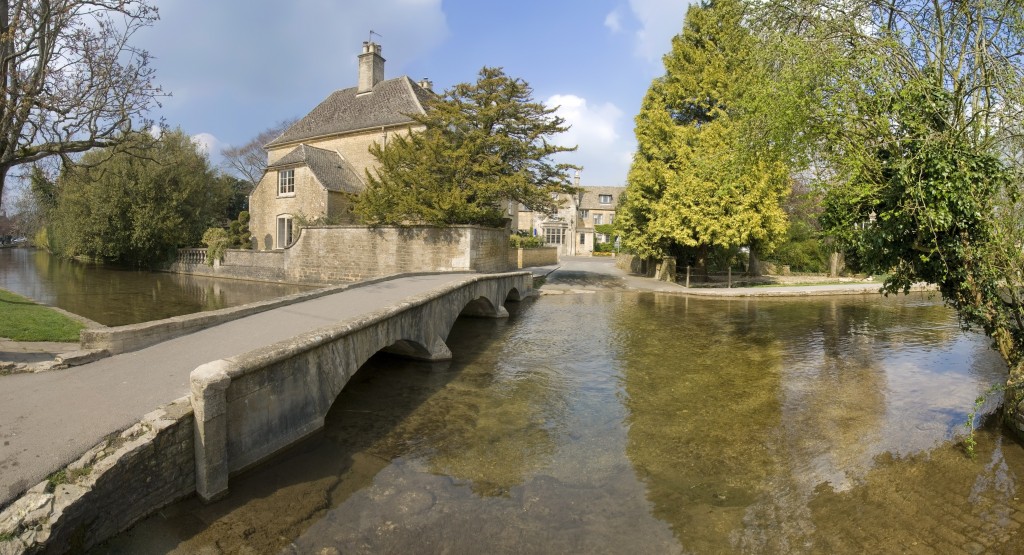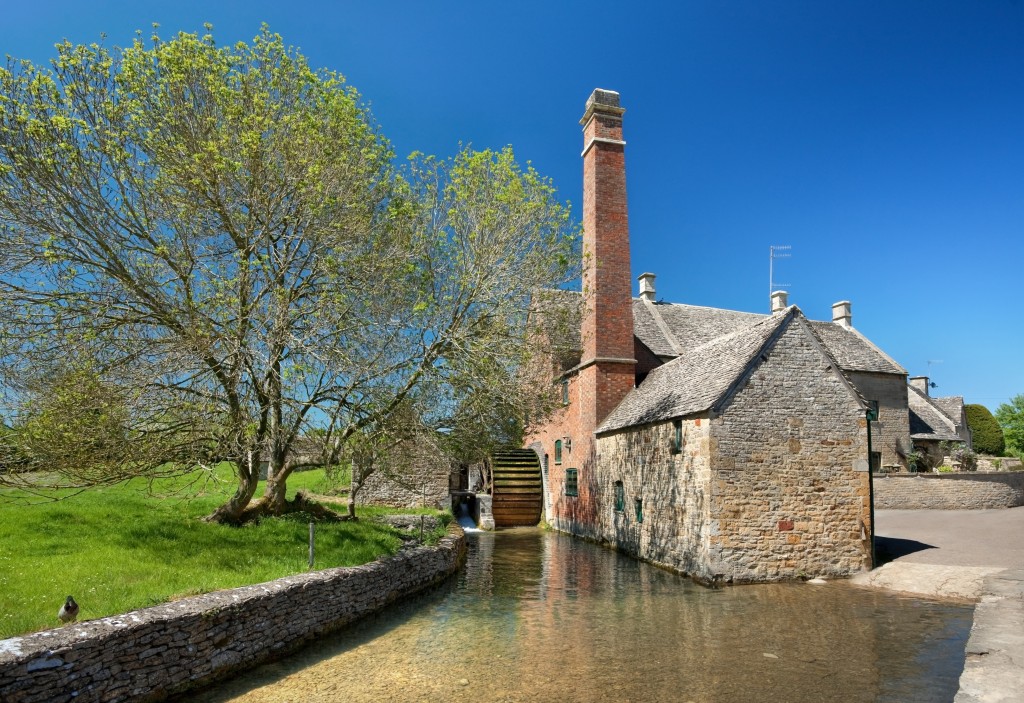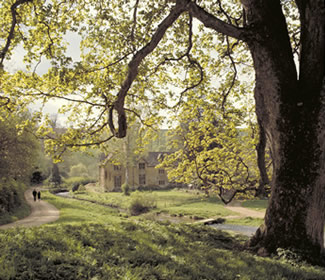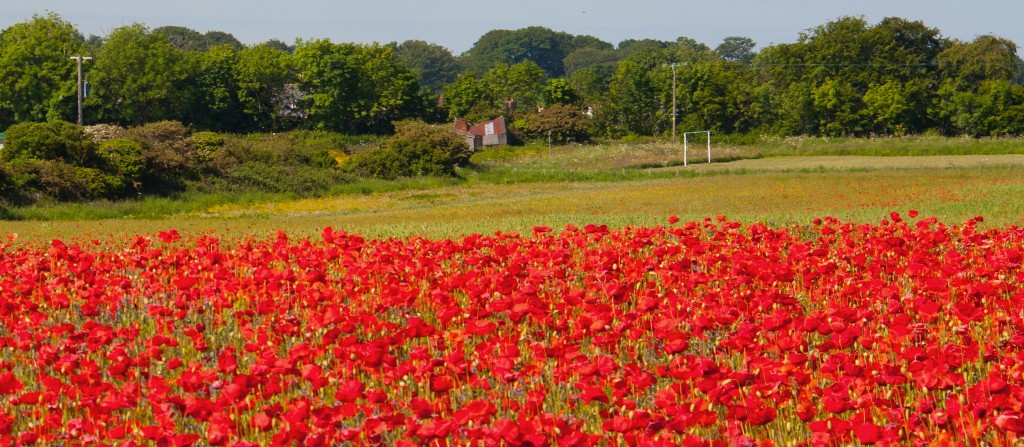Walking the Cotswold Short Break
Wander along the route of the Cotswold Short Break with Amy Watson as she describes her walking holiday.
Walking the Cotswold Short Break
https://www.contours.co.uk/enchanted-lands-the-cotswolds
Having just commemorated one-hundred years since the outbreak of World War One, one of the most poignant experiences of walking the Cotswold Short Break from Bourton-on-the-Water recently, was paying a visit to the picturesque villages of Lower and Upper Slaughter. In not too many words, I’d love to share my experience…
With a full stomach and wearing my most comfortable (well-worn) walking boots, I left the Gloucestershire B&B where I had spent a wonderfully comfortable night sleeping and laid some tracks down Bourton-on-the-Water’s High Street. This first leg of my journey, which was leading me toward the little village of Lower Slaughter (yes, I too felt the name was a tad misleading), was marked by the quiet path of the River Windrush to my left and a neat line of Cotswold-sandstone cottages to my right.

I had arrived in Bourton-on-the-Water on the Friday and, as I had planned, started walking the following day. There were surprisingly few cars on the road and, even more surprisingly, very few walkers heading in the same direction as myself. I was getting used to this, but not quite. I had only encountered two other groups of walkers during my explorations of the village the previous day, but now we were well and truly ‘of the weekend’, it did strike me as strange that more people weren’t pulling on their boots and enjoying the fantastic scenery and hospitality that the Cotswolds had to offer (yes, I may have stopped for tea and scones on a few occasions).
Fuelled by a great cooked breakfast and a tasty Cotswold Cream Tea (or two), I walked along the Windrush and, before long, bumped into (no, not literally) a fellow wanderer. After a quick ‘good morning’, a semi-rhetorical ‘lovely day for it isn’t it?’ and a mortifyingly British ‘great weather we’re having…for a change’, we parted company and, as he headed back towards Bourton-on-the-Water, I made a left-turn onto a blanket of green fields. Buttercup-strewn borders and fuzzy, full hedges greeted me, as did a plethora of pretty wild flowers and a single sleepy-eyed female pheasant.
Being a native of the Peak District, and therefore ‘well-conditioned’ to coping with hills, my legs couldn’t have been happier having discovered that the scenic walk towards Lower Slaughter was both enjoyable and relatively flat! Furthermore, although my map told me that I was never too far from civilisation, the peace and tranquillity of the whole setting made me believe that I had unwittingly wandered into some quiet paradise that I had the privilege of sharing only with butterflies, bumblebees and the odd buzzard that circled above.


Walking down a narrow lane sheltered by trees, my thoughts of such a paradise were interrupted when I caught sight of a huddle of yellow cottages contained by mossy dry-stone walls, alongside which grew a host of purple Bellflower, pink Coralbells and pure white Foxgloves. As I admired these quaint Cotswold Cottages, all of which had gardens that would be the envy of gardeners countrywide, I came to recall a story I had heard about a former resident of Lower Slaughter: Gordon Mitchell, the son of RJ Mitchell, the designer of the Spitfire plane. This thought led me to cast my mind back to one of the main reasons I had chosen to walk one of the Cotswold Circular Walks in the first place: the ‘Thankful Village’.
Unlike the overwhelming majority of British parishes, Upper Slaughter, where I would soon be arriving, has no war memorial commemorating the local men who were lost during World War One. This is not because the village has forgotten them, nor is it because it does not care. Upper Slaughter is one of only fifty-three parishes in the UK that suffered no military fatalities during World War One. Of the twenty-five villagers who left between 1914 and 1918, not a single one of them was unable to return home.
 Unlike Upper
Slaughter, many other Cotswold Villages have a war memorial.
Unlike Upper
Slaughter, many other Cotswold Villages have a war memorial.
Only a few weeks prior to beginning the Cotswold Short Break, I had been reading Arthur Mee’s Enchanted Land (1936). In it, Mee spoke of thirty-two ‘Thankful Villages’ in Britain and lamented that not one of these villages visibly commemorates the men and women who survived. So, my plan: to visit one of these ‘Thankful Villages’ and to see if, like Arthur Mee claimed in 1936, there was still no mention of the brave men and women of World War One who left and, unlike so many others, all returned!
The men of Upper Slaughter, like those from other areas, had travelled to join the lines of fighting at places like Ypres, Verdun and Gallipoli. The women of the village, such as Agnes Witts, were joining the Coluntary Aid Detachment (VAD) and were providing vital nursing services just shy of the frontline.
As I passed through Lower Slaughter, I struggled to imagine the sights, sounds, smells and memories that World War I’s survivors brought back to their homes in quiet little villages like this. I soon remembered some words from ‘The Send-Off’ by Wilfred Owen:
Down the close, darkening lanes they sang their way
To the siding-shed,
And lined the train with faces grimly gay
So secretly, like wrongs hushed-up, they went.
They were not ours:
We never heard to which front these were sent.
Shall they return to beatings of great bells
In wild trainloads?
A few, a few, too few for bells and yells
May creep back, silent, to still village wells
Up half-known roads.
Although my image of boisterous villagers cavorting their way to the train station wasn’t too far off at War’s outbreak in 1914, by 1918, these voices had long been silenced and the pride of many local villages, just like Lower Slaughter – that their men had bravely gone to war, had been replaced with an unspoken sorrow that too few of these young heroes would return to the parishes that had sheltered them during their childhoods. For some, the smiles and pride that accompanied their leaving the village all those years ago would not return with them.
Taking to Britain’s trails nowadays, one rarely fails to come across some visible mark of World War One or Two upon the landscape: a moss-covered observation post, an aging stone memorial, a field of blood-red poppies. There is always a memorial somewhere. What Arthur Mee and Wilfred Owen had both noticed, is the fact that they, unlike so many others, had been allowed to keep the gift of their own lives – What is given to those who were not lost? What of those who returned?
Thoughtful, and after taking quite a few photographs of my surroundings, I reached the village of Upper Slaughter. The ‘Thankful Village’. Like Lower Slaughter before it, it was abundantly charming: a quaint gathering of honey-coloured stone cottages huddled around a turreted Norman church and a gabled Elizabethan Manor House. As I approached the village Square, I met a young wellington-wearing family from Somerset who, I found out, were marching their way toward the Ford that crosses the River Eye at the edge of the village. Staying a few paces behind them and with the Church to my left, I made my own way over too and discovered that, although the water was reasonably shallow at the crossing, wellingtons or study waterproof boots were a must! Choosing to keep my feet dry, I strolled toward a small bridge a little further along the River and crossed there instead!


After this watery interlude, I turned back towards the Square. Surrounded by medieval alms-houses and eighteenth and nineteenth-century stone cottages, the Square looked like just the place where all of those men and women may have gathered for the last time before leaving their homes in 1914.
Looking around me, I could find no record of any of the twenty-five men and women who had left the village one-hundred years previously. Did the current residents of Upper Slaughter realise that they were one of only a few parishes in Great Britain where all of their Servicemen were allowed to return home from a fight that had cost so many others their lives? They must know.
I decided to stay in Upper Slaughter for a little longer than I had originally planned and, even though I could feel my map pulling me towards Naunton (the next stop on my Cotswold’s’ Adventure), I chose instead to make my way to St. Peter’s Church. If there wasn’t a monument in the Square, there would surely be one there!?
On my way, I passed the Village Hall. Sitting outside of it, I found my first local. He was very friendly and I managed to find out, from careful interrogation, that he was on his way back from the ‘paper run’. I learnt that this was a weekly trip he took to visit a friend who lived on the opposite side of the village and, as this friend worked in nearby Cheltenham and therefore had access to a number of ‘mod-cons’ including a ‘paper shop’, he would collect a full-week’s worth of newspapers and pass them over to the gentleman I was now speaking to. Anyway, once I had found out all about Upper Slaughter’s love of recycling local newspapers, I asked my new friend what he thought about living in a ‘Thankful Village’ and whether there was anything in the Village commemorating its World War One survivors. He raised an eyebrow – I assumed this meant that it was not the first time he had been asked this question by an overenthusiastic tourist – but, very graciously, he pointed me in the direction of the Village Hall. He also told me that the Church Records were a wealth of information for those interested in Upper Slaughter’s war heroes.
Thanking my newly appointed Comrade in Investigations for his help, I turned on my heel and left him to his recycled newspapers. I felt like I was getting close! To add to my excitement, I also noticed that the Village Hall was serving tea and cakes - double success! Jumping the (four) steps up to the entrance of the hall, I tumbled into a small cream, photographed-bedecked room that was full of mismatched wooden chairs and tables with contrasting linens of all shapes and sizes. I was ushered to a little table at the other end of the hall by a very smartly dressed, grey-haired lady who promptly and enthusiastically brought me out a pot of tea for one and a very generous slice of homemade Carrot Cake. After she enquired as to my journey so far, I revealed to her my wish to find information about ‘the twenty-five’ of Upper Slaughter…and, obviously pleased with my interest in her village’s history, she led me towards the back of the Hall…

Underneath a large open window, two large dark-oak plaques were mounted on the wall. Just above the two plaques was a small Union Flag and surrounding them were some photographs of men and women in World War One uniforms, as well as a few photographs of other famous locals. There were also two small wall lights. I had just been introduced to Upper Slaughter’s ‘Rolls of Honour’: one for World War One and one for World War Two.
Upper Slaughter never lost a single life to World War One. It is also one of thirteen never to have lost a life during World War Two as well. Miraculously, as the Rolls of Honour evidenced, the village avoided any fatalities during the Wars and is, therefore, ‘doubly thankful’.
Before polishing off my tea and cake, I took a minute in remembrance during which time my mind strayed to think of my late-Uncle Jack who, because of the atrocities he had seen committed, could never feel pride for the part he played during World War Two. Despite this memory, I was pleased that the people of Upper Slaughter, all of whom were able to return home at wars’ end, were remembered just as fondly as those who were not always so blessed.
You can follow in Amy’s footsteps and visit the ‘Thankful Village’ of Upper Slaughter on our Cotswold Short Break, a 26-mile long circular walk from Bourton-on-the Water via Winchcombe and the Windrush Valley. You can also visit the village on our Cotswold Round, a 51-mile long circular walk from Moreton-in-Marsh, or our longerCotswold Villages Trail, a 64.5-mile long circular walk that also starts in Moreton-in-Marsh.
If you’d rather, you can go and explore your own ‘Thankful Village’ and could choose to visit Puttenham on the North Downs Way or Hebrandston on the Pembrokeshire Coast Path.